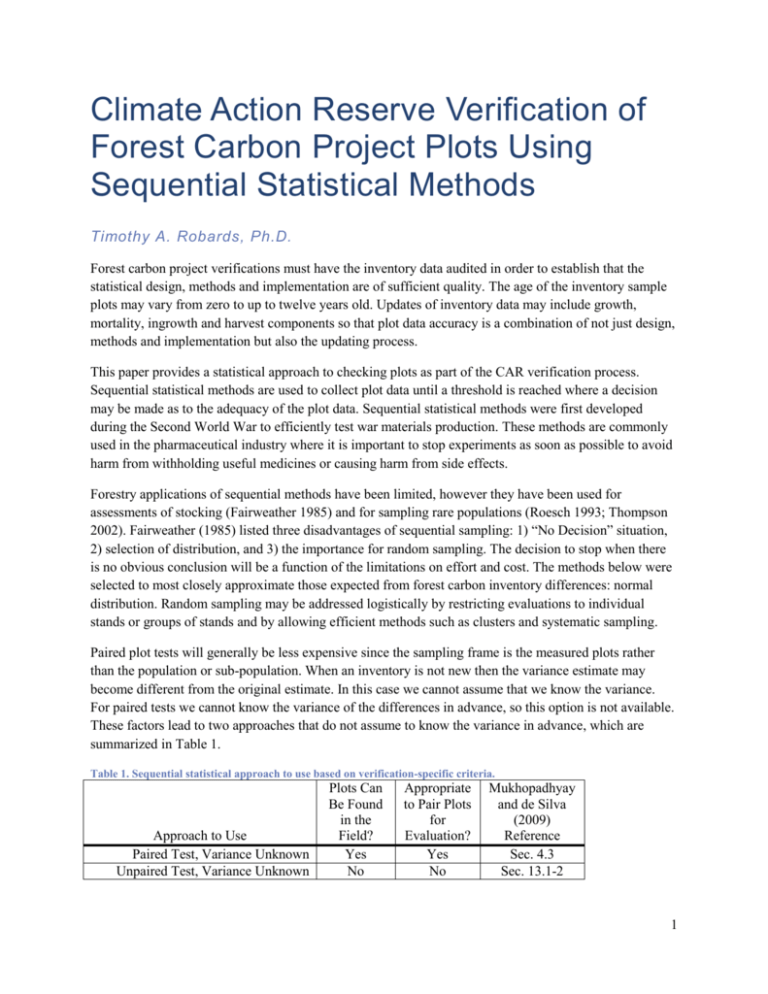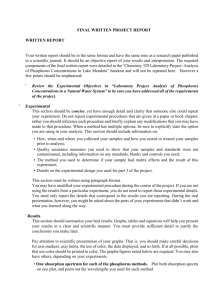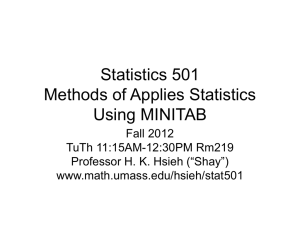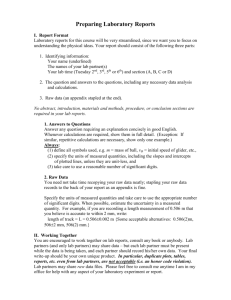Verification of Forest Carbon Project Plots Using Sequential
advertisement

Climate Action Reserve Verification of Forest Carbon Project Plots Using Sequential Statistical Methods Timothy A. Robards, Ph.D. Forest carbon project verifications must have the inventory data audited in order to establish that the statistical design, methods and implementation are of sufficient quality. The age of the inventory sample plots may vary from zero to up to twelve years old. Updates of inventory data may include growth, mortality, ingrowth and harvest components so that plot data accuracy is a combination of not just design, methods and implementation but also the updating process. This paper provides a statistical approach to checking plots as part of the CAR verification process. Sequential statistical methods are used to collect plot data until a threshold is reached where a decision may be made as to the adequacy of the plot data. Sequential statistical methods were first developed during the Second World War to efficiently test war materials production. These methods are commonly used in the pharmaceutical industry where it is important to stop experiments as soon as possible to avoid harm from withholding useful medicines or causing harm from side effects. Forestry applications of sequential methods have been limited, however they have been used for assessments of stocking (Fairweather 1985) and for sampling rare populations (Roesch 1993; Thompson 2002). Fairweather (1985) listed three disadvantages of sequential sampling: 1) “No Decision” situation, 2) selection of distribution, and 3) the importance for random sampling. The decision to stop when there is no obvious conclusion will be a function of the limitations on effort and cost. The methods below were selected to most closely approximate those expected from forest carbon inventory differences: normal distribution. Random sampling may be addressed logistically by restricting evaluations to individual stands or groups of stands and by allowing efficient methods such as clusters and systematic sampling. Paired plot tests will generally be less expensive since the sampling frame is the measured plots rather than the population or sub-population. When an inventory is not new then the variance estimate may become different from the original estimate. In this case we cannot assume that we know the variance. For paired tests we cannot know the variance of the differences in advance, so this option is not available. These factors lead to two approaches that do not assume to know the variance in advance, which are summarized in Table 1. Table 1. Sequential statistical approach to use based on verification-specific criteria. Approach to Use Paired Test, Variance Unknown Unpaired Test, Variance Unknown Plots Can Be Found in the Field? Yes No Appropriate to Pair Plots for Evaluation? Yes No Mukhopadhyay and de Silva (2009) Reference Sec. 4.3 Sec. 13.1-2 1 Based on the criteria in Table 1 and professional judgment, a verifier selects an approach to use. The two approaches are discussed below. A spreadsheet tool is available to aid in the calculations; each approach may be found in a separate worksheet. These methods were taken from the book Sequential Methods and Their Applications by Mukhopadhyay and de Silva (2009). The terminology was adjusted to make it consistent for our purposes. The last column in Table 1 shows where the method was found in the book. Paired Test, Variance Unknown We assume that the verification plots can be paired with project plots. Definitions Let Xi = Pi - Vi where, Pi = project mean on plot i, Vi = verification mean on plot i, X1, X2, … is iid N(µ, σ2). Let Zα = α% N(0,1) where, α = error parameter. Let Zβ = β% N(0,1) where, β = power parameter. Let 𝑋̅𝑁 = sample mean of the Xi’s where, N = total number of plots measured. Let Sn2 = sample var. of the Xi’s where, n = number of plots measured. Let D = δ × P where, δ = percent deviation allowed (i.e. 5%, 10%, 20%), P = mean estimate from project. Let K = (Zα × D) / (Zα + Zβ) Hypothesis H0: µ = 0 HA: µ = D. Parameters Set δ = 10%, α = 0.05, β = 0.20, minimum number of plots = 5. Procedure 1) Sample a minimum number of plots, but never less than 2. 2) If n ≥ ((Zα + Zβ)2 × Sn2) / D2 then STOP and Evaluate a. Evaluate: 2 If If 𝑋̅𝑁 ≤ K then accept H0, 𝑋̅𝑁 > K then reject H0. 3) Otherwise, take one more sample and return to step 2. Spreadsheet Use Enter the data from the project inventory and parameters in the orange cells in the upper left of the worksheet. Then enter the project and validation plot data in the orange cells, as the data is collected. There is a figure to the right that shows how the data looks relative to the stop-sampling thresholds. The “Condition” column will tell you whether to sample another plot or if the stopping condition is met. If the stopping condition is met then it will also tell you the results of the test. Unpaired Test, Variance Unknown We assume that the verification plots cannot be paired with project plots. This test is based on a comparison of two normal means where sampling is conducted from each population until sufficient data from each is collected to construct a fixed confidence interval. In this case we assume that sufficient data has been collected from the project inventory and only collect additional data from the verification sample. Definitions Let Xi = Vi where, Vi = verification mean on plot i, X1, X2, … is iid N(µV, σV2). Let Tn = 𝑋̅𝑃 - 𝑋̅𝑛𝑣 where, 𝑋̅𝑃 = project mean, 𝑋̅𝑛 = verification mean after sample n. Let D = δ × µP where, δ = percent deviation allowed (i.e. 5%, 10%, 20%). Let n = nP + nV. Let a = 50α% N(0,1). Hypothesis H0: µV = µP HA: µV = µP + D. Parameters Set δ = 10%, α = 0.05, minimum number of plots = 5. 3 Procedure 1) Sample a minimum number of plots, but never less than 2. 2) Calculate 𝑋̅𝑛 , Tn, and S n2 𝑣 v 3) If n ≥ (a2/D2) × (Sn2 + SP2) then STOP and Evaluate a. Construct the confidence interval. Tn ± D. b. Evaluate: If the confidence interval includes zero then accept H0, Otherwise reject H0. 4) Otherwise, take one more sample and return to step 2. Spreadsheet Use Enter the data from the project inventory and parameters in the orange cells in the upper left of the worksheet. Then enter only the validation plot data in the orange cells, as the data is collected. There is a figure to the right that shows how the fixed confidence interval looks relative to the null hypothesis threshold (zero). The “Condition” column will tell you whether to sample another plot or if the stopping condition is met. If the stopping condition is met then it will also tell you the results of the test. References Fairweather, S.E. 1985. Sequential sampling for assessment of stocking adequacy. Northern Journal of Applied Forestry 2:5-8. Roesch, F.A. 1993. Adaptive cluster sampling for forest inventories. Forest Science 39(4):655-669. Thompson, S.K. 2002. Sampling. John Wiley and Sons, New York. 4






